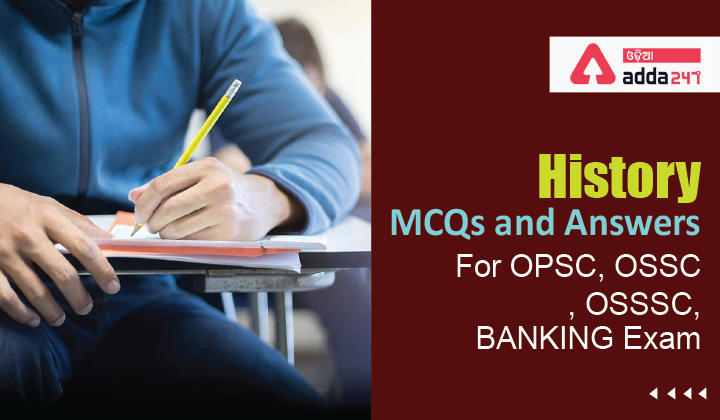History MCQs and Answers: History MCQs are very important for OPSC, OSSC, OSSSC & Other State Exams. Aspirants who are willing to apply for the various Government exams 2022 must go through the topics of History for competitive exams, as History is a key part of the syllabus.
Download ADDA247 Odia APP – Appear Latest Exam Test Series & Live Classes
Q1. Who is known as the ‘Nepolean of India’?
(a) Chandragupta II
(b) Samudragupta
(c) Chandragupta I
(d) Chandragupta Maurya
S1. Ans(b)
Sol. The Gupta Kingdom was enlarged enormously by Chandragupta’s son and successor Samudragupta. Samudragupta is called the ‘Nepoleon’ of India.
Q2. Who was the President at Surat sesssion of congress in 1907?
(a)Rasbehari Ghosh
(b) Rasbehari Bose
(c) A C Majumdar
(d) DadabhaiNaroji
S2. Ans(c)
Sol. A C Majumdar was the President at Surat session of congress in 1907.
Q3. Who built the jama masjid?
(a)akbar
(b) shah jahan
(c) Qutbuddin Aibak
(d) Sher Shah Suri
S3.Ans(b)
Sol. It was built by the Mughal emperor Shah Jahan between 1650 and 1656. It is the one of the largest mosques in India.
Q4. Who was the second woman to become the president of the Indian National Congress in 1925 and the first Indian woman to do so?
(a) Vijaylakshmi Pandit
(b) Sarojini Naidu
(c) Padmaja Naidu
(d) Fathima Bibi
S4. Ans.(b)
Sol.Sarojini Naidu was the second woman to become the president of the Indian National Congress in 1925 and the first Indian woman to do so.
Q5. When did the 1857 revolt take place?
(a)21 may 1857.
(b) 09 may 1857.
(c) 31 may 1857.
(d) 10 may 1857.
S5. (d)
Sol.The rebellion began on 10 may 1857 in the form of a mutiny of sepoys of the company’s army in the garrison town of Meerut , 40 mi (64 km) northeast of Delhi ( now old Delhi).
Q6. Who was the first Chief Justice of Supreme Court of Calcutta?
(a) Hyde
(b) Elijah Impey
(c) Lemaistre
(d) Monson
S6.Ans.(b)
Sol. Sir Elijah Impey was a British judge, the first chief justice of the Supreme Court of Judicature at Fort William in Bengal.
Q7. The basic purpose of the formulation Din-i-Ilahi was:
(a) universal brotherhood
(b) universal faith
(c) universal harmony
(d) universal belief
S7. Ans.(b)
Sol. Din-iIlahi “the religion of God,” was a system of religious beliefs proposed by the Mughal emperor Akbar in 1582 CE. The idea was to combine Islam and Hinduism into one faith, but also to add aspects of Christianity, Zoroastrianism and Jainism — the latter an ancient Indian creed which emphasized non-violence and vegetarianism.
Q8. Gautam buddha gave is first sermon at?
(a) Sarnath
(b) Kapilvastu
(c)Vaishali
(d) Kushinagar
S8. Ans(a)
Sol. Gautam Buddha gave his first sermon at Sarnath.

Q9. Bahadur Shah was the
(a) last ruler of the Lodis
(b) successor of Sher Shah Suri
(c) last Mughal ruler
(d) successor of the Maratha ruler Shivaji
S9. Ans.(c)
Sol.Mirza Abu Zafar Sirajuddin Muhammad Bahadur Shah Zafar was the last Mughal emperor. He was the second son of and became the successor to his father, Akbar II, upon his death on 28 September 1837.
Q10. Which was the port city of Indus Valley civilization?
(a) Kalibanga
(b) KotDiji
(c) Lothal
(d) Mohenjodaro
S10. Ans(d)
Sol. Mohenjodaro was the port city of Indus Valley civilization.
Q11. The Charter Act of 1793 Renewed the Company’s monopoly for____________ years.
(a) 20 years
(b) 10 years
(c) 30 years
(d) 15 years
S11.Ans.(a)
Sol. Every charter act renwed company licence for 20 yrs.
Q12. Who did not find a place in the Legislative Council as per the Act of 1853?
(a) The Governor-General
(b) Additional Members
(c) The Commander-in-Chief
(d) The Lieutenant Governor
S12.Ans.(d)
Sol. Charter Act of 1853 marks the expansion of the Council of the Governor General for legislative purposes. The council of legislative purposes which had 6 members now was expanded to 12 members.The member are Governor General , commander in Chief, four members of the Governor General’s Council etc.
Q13. The Governor-General was given power to issue ordinances by the act of
(a) 1858
(b) 1861
(c) 1860
(d) 1871
S13.Ans.(b)
Sol. The Indian Councils Act 1861 was passed by British Parliament in 1861 to make substantial changes in the composition of the Governor General’s council for executive & legislative purposes. The most significant feature of this Act was the association of Indians with the legislation work.
Q14.Which Governor General abolished the ‘Sati System’ in India?
(a) Lord Canning
(b) Lord Ripon
(c) Lord Wiliam Bentinck
(d) Lord Dalhousie
S14. Ans.(c)
Sol. The Bengal Sati Regulation which banned the Sati practice in all jurisdictions of British India was passed on December 4, 1829 by the then Governor-General Lord William Bentinck.
Q15.The tax collected by Marathas was known as
(a) Chauth
(b) Pilgrim Tax
(c) Jazia
(d) Charai
S15.Ans.(a)
Sol. Chauth was a regular tax or tribute imposed, from early 18th century, by the Maratha Empire in India. It was an annual tax nominally levied at 25% on revenue or produce.














